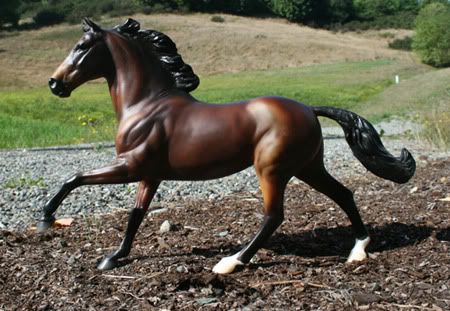Since today’s post is just about breed assignment, I’ve removed realism and basic conformation from the picture by using four horses of the same mold: Flash. This mold is nice example of a few things: A) he’s another example of a mold that doesn’t show well as the breed it’s meant to depict and B) he’s pretty generic and can shown as a number of different breeds.
Not all breed assignments are created equal. Some assignments are easier because the breed is common (or at least popular in the hobby) and no documentation is required. Some more obscure breeds can be researched with some ease via popular breed books. Other breeds are almost unheard of and may require you to speak a foreign language to track down enough information about them. For this post, I’ll be including levels of difficulty for each assignment.
Horse #1:
 Breed: Morgan
Breed: MorganDifficulty: Moderate to High
The difficulty here is justifying the pinto, pattern, and the body type for this assignment. Difficulty gets exponentially higher when you’re looking for all these characteristics in one real life example.
Horse #2:
 Breed: Connemara cross
Breed: Connemara crossDiffculty: Easy
This is the breed assignment of the original mold, the breed is considered common, and the color is well known in Connemaras.
Horse #3:
 Breed: New Forest Pony
Breed: New Forest PonyDiffuculty: Moderate
The trick with this assignment is his color. In the US, this color is called buckskin but in Europe (and by the Connemara registry) it’s called dun. Genetically, the terms dun and buckskin refer to completely different colors that look vaguely similar. This issue gets substantially cloudier because most Americans (including the Buckskin Regisrty…which you’d think would know better) also call dun “buckskin.”
*headdesk* *headdesk* *headdesk*
Horse #4:
 Breed: Quarter Pony
Breed: Quarter PonyDifficulty: Easy
A common breed in its most common color. No documentation needed, right? (Wrong…I’ll get to this in a minute.)
Feel free to take a minute and decide for yourself how you’d place this class (and feel free to post your placings in the comments. Don’t be afraid to disagree with mine just because it’s my blog.)
*
*
*
*
*
*
All done? Okay, my turn:
Forth place - Connemara cross
This is the most common mistake I see new showers make. If you are going to show a horse as a cross, please tell me what is was crossed with. I know in the real world that sometimes you don’t know a crossbreed’s exact mix, but these aren’t real horses. We’re making things up, so you might as well make up the other half, too. Saying a horse is just half one breed, but not another is kinda like doing half of your homework. (I’ll come back to crosses in more detail tomorrow.)
Third place - Morgan
Let’s say this horse was shown with photos of this horse and this horse for documentation. The documentation demonstrates that, although rare, pure-bred Morgans can both be overo and have dark legs on a palomino. A for effort, but his color isn’t my problem with this assignment. The Flash mold lacks several essential characteristics that make the Morgan unique. To make a better Morgan, his neck should be longer, arched, and cresty with a cleaner (thinner) throatlatch. His head should be longer with a petit muzzle and larger, hooked ears. To his credit, Flash has a compact, athletic body with those lovely massive Morgan feet I adore on my own mare.
Second Place - Quarter Pony
The Quarter Pony is a developing breed and their registry is open to horses of unknown parentage. As a result, you’ll see a lot of registered Quarter Ponies that look like Flash, athletic and generic. However, the registry specifically requires that “ponies must be easily recognizable as having characteristics of quarter-type or quarter bred ponies.” Again, the neck and head are an issue. His neck and headset should be much lower. Muzzle should be smaller and the head finer overall. I’d like to see larger hindquarters, as a Quarter Pony is ideally just a short Quarter Horse.
Having said that, judges are susceptible to persuasion. You can find numerous examples of athletic ponies of mixed heritage that are registered as Quarter Ponies and resemble Flash. A great photo showing a real life example makes a strong argument to a judge.
First Place - New Forest Pony
For once, a breed assignment that fits Flash’s head and neck! While you can find exceptions, short pony-eque necks and course boxy heads are common within the breed. Athletic bodies with horse like proportions are increasingly becoming the norm outside of the New Forest, as these native breeds have increasingly been bred for dressage, hunt, and jumping.
The trick with New Forest Ponies is that this is one of those breeds people think they know because they show up in a lot of breed books. Body types vary with Shetland pony-like proportions (long bodies, short legs) on one end and mini warmbloods (below) on the other extreme. As a shower, you have no control over which type a judge has in mind at the start of the day, but you can influence them to reassess their assumptions through good documentation.







No comments:
Post a Comment
Moderation is off. Please don't make me turn it on.